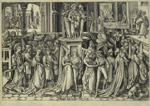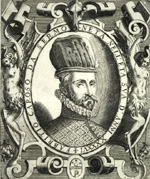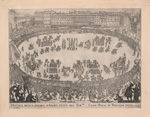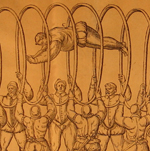Genesis of A Tradition
Feast of Salomé

Feast of Salomé
Engraving by Israel(Israhel)
van Meckenem, [149-?].The
Biblical figure of Salomé, who danced for her stepfather
Herod and received the head of John the Baptist on a platter
in return, was a popular subject of Renaissance art.Here,
in one of the collection's very oldest objects, the theme
appears in the upper vignettes, while the main image depicts
a contemporary scene of dancing and music-making.Cia
Fornaroli Collection, Jerome Robbins Dance Division.
Portrait
of Fabritio Caroso da Sermoneta at the Age of 46

Portrait of Fabritio Caroso
Plate
from Caroso's treatise Il Ballarino, published in
Venice in 1581.A prominent Italian dancing master, Caroso
published two of the chief sources of late Renaissance social
dance--Il Ballarino (The Dancer) (1581) and the revised
and expanded Nobiltà di dame (The Nobility of Ladies)
(1600).Generously
illustrated and magnificently printed, with dedications to
ladies of high rank, they give the choreography and music
for more than a hundred dances performed by the Italian nobility.Il
Ballarino was the first printed treatise
on dancing and choreography, and thus, unlike the fifteenth-century
treatises by Domenico da Piacenza, Antonio Cornazano, and
Guglielmo Ebreo, which were in manuscript form, it circulated
beyond a small circle of disciples and connoisseurs.Although
Caroso's book had a pedagogical aspect, he went beyond the
emphasis of earlier treatises on steps and body postures
to incorporate history.At
the same time, he used layout, ornament, and design to enhance
the graphic quality of the book.Cia
Fornaroli Collection, Jerome Robbins Dance Division.
La Guerra d'Amore (The War of Love)

La Guerra d'Amore
Etching by Jacques Callot, [Florence],
1615.Performed by
knights on horseback, seventeenth-century horse ballets combined
eye-filling spectacle with music, poetry, and elaborate choreography.
The
War of Love, staged for Cosimo II de' Medici in 1615,
took place in the Piazza Santa Croce of Florence and
featured a mock battle and tournament.In
this etching, one of several by Jacques Callot, African and
Asian floats designed by Giulio Parigi bring an exotic note
to the pageantry.Horse ballets, often staged by ballet masters
imported from Italy,
became extremely popular in France and Austria during
the seventeenth century.As
in Florence, these elaborate
performances, involving hundreds of participants, offered
powerful assertions of state and dynastic power.Cia
Fornaroli Collection, Jerome Robbins Dance Division.
Cosimo Ticcio, Manoscritto di balletti composti da Giovannino e Il Lanzino
e Il Papa; scritto da Cosimo Ticcio (Manuscript of ballets composed
by Giovannino, Il Lanzino, and Il Papa). [155-?]. This mid-sixteenth-century
manuscript, written by Cosimo Ticcio and one of the oldest objects in the
Cia Fornaroli Collection, contains descriptions of fifteen dances, with
an introduction by a Florentine dancing master who calls himself "Il
Papa" (or "The Pope"). Two of the dances are his; two others
are by "Il Lanzino," whose nickname may indicate that, like the
mercenary soldiers known as lanzichenecchi (Lansquenets), he was
from Germany or northern Europe. The remaining eleven dances are attributed
to "Giovannino" (Little John), dancing master to Lorenzo de'
Medici, the grandson of Lorenzo the Magnificent, the great patron of Florentine
art. Although no music is given, the titles suggest that several of the
dances were accompanied by popular songs. This collection is a rare source
documenting the transition from the fifteenth-century dances of Domenico
da Piacenza and Guglielmo Ebreo to the late sixteenth-century balletti of
Fabritio Caroso and Cesare Negri. The first page is displayed along with
Walter Toscanini's handwritten transcription of the introduction, signed "Il
Papa." Cia Fornaroli Collection, Jerome Robbins Dance Division.
Cesare Negri, Le gratie d'amore, di Cesare Negri Milanese, detto il
Trombone, professore di ballare, opera nova, et vaghissima, divisa in tre
trattati (The Graces of Love, by Cesare Negri, Milanese, called "The
Trombone," teacher of dancing, a new and most admirable work, divided
into three treatises). Engravings by Leone Pallavicino after drawings
by Giovanni Mauro della Rovere.Milan, 1602. Digitized images of the title
page and selected plates. This splendid treatise, published in Milan in
1602, includes social dances as well as a group of theatrical dances composed
in 1599 for the entry into Milan of the Spanish Infanta Isabella and her
husband, Albert, the Archduke of Austria. Couple dances predominate among
the social dances, but Negri also describes two-couple dances, virtuoso
step combinations for male performers, and complex spatial patterns such
as the snail figure known as "winding up the ball of yarn," all
in unusually rich detail. Sixteenth-century Italian dance masters traveled
widely, and Italian influence was evident throughout Europe, especially
in the elaborate entertainments that were a feature of court life. The
vivid images are by the well-known Milan painter Giovanni Mauro della Rovere. Cia
Fornaroli Collection, Jerome Robbins Dance Division.

Arcangelo Tuccaro
Arcangelo Tuccaro, Trois dialogues de l'exercice de savter, et voltiger
en l'air. Auec les figures qui seruent à la parfaicte demonstration & intelligence
dudict art. Par le Sr. Archange Tvccaro, de l'Abruzzo, au Royaume de Naples (Three
dialogues on the practice of jumping and vaulting in the air. With figures
that will serve as a perfect demonstration and understanding of said art. By
Sieur Archange Tuccaro, of the Abruzzo, in the Kingdom of Naples).Paris,
1599. Digitized images of selected plates. An acrobat and ballet master,
Tuccaro was
hofspringmeister to the Holy Roman Emperor Maximilian
II and subsequently master of ceremonies and choreographer to the French
court in Paris, where this manual in dialogue form was published. The
emphasis on gymnastics, both in the text and the accompanying images, suggests
the rapid professional development of theatrical dance in the late sixteenth
century.Lincoln Kirstein Collection, Jerome Robbins Dance Division.
Antoine Arena, Ad suos compagnones studiantes qui sunt de persona friantes,
bassas dansas et branlos practicantes, nouuiellos quamplurimos mandat: his
posterioribus diebus grassis augmentatus, & a mandatis Conardorum Abbatis
YO, de Rothomago, in lucem enuoyatus / Antonius De Arena Provencalis de
Bragardissima Villa de Soleriis (Antonius De Arena, Provençal of the
most Gallant Town of Soliès, enlarged in these recent meat-eating days
and ordered into the light by Conard, Abbot of [the Order of Y], in Rouen,
sends to his student companions, ardent of person and practitioners of
bassedanses and branles, all possible greetings).Rouen, 1670. First
published in 1529, decades before Fabritio Caroso's Il Ballarino (1581)
and Cesare Negri's Gratie d'amore (1602), this treatise remained
popular reading into the eighteenth century. Written in macaronic Latin--a
mixture of Latin and the vernacular (in this case Provençal) associated
with burlesque literature--Arena addresses his fellow law students, explaining
in detail the choreography of nearly sixty dances (nearly all examples
of the bassedanse). At the same time he urges them to mind their
manners, improve their conversation, and master the rules of genteel deportment,
promising success with the ladies as a reward. Cia Fornaroli Collection,
Jerome Robbins Dance Division.
Lotto Lotti, L'idea di tutte le perfezioni, introduzione al balletto
de' serenissimi principi Francesco, e Antonio Farnesi, fatto rappresentare
dal sereniss. sig. dvca di Parma nel svo nvovo teatrino, in occasione de'
felicissimi sponsali del serenissimo sig. principe Odoardo svo primogenito,
con la serenissima signora principessa Dorotea Sofia di Neobvrgo (The
Idea of All Perfections, introduction to the ballet of the Most Serene
Princes Francesco and Antonio Farnesi, represented on the order of the
Most Serene Duke of Parma in his new small theater, on the occasion of
the felicitous nuptials of his eldest son, the Most Serene Prince Odoardo,
with the Most Serene Princess Dorotea Sofia of Neuburg).Piacenza, 1690. This
scenario, with its six etchings, records a magnificent court ballet staged
in the duchy of Parma by the ruling Farnese family. The choreography was
by Giacomo Duridò and the scenery by the brothers Ferdinando and Francesco
Galli Bibiena, founders of the celebrated family of stage designers and
architects. Appointed Ranuccio II's chief painter and architect, Ferdinando
worked at the ducal courts of Parma and Piacenza for nearly thirty years,
providing the scene decorations for numerous theatrical entertainments
(such as this ballet). His most important innovation was the scena
veduta in angolo--theatrical settings that used diagonal (as opposed
to single-point) perspectives to create spectacular architectural illusions,
Baroque fantasies of soaring vaults and arches, sweeping curvilinear balconies
and balustrades, and a profusion of elaborate decoration. For the next
hundred years, members of the Bibiena family built theaters and decorated
royal festivities throughout Europe, their work inspiring stage designers
for centuries. This etching displayed shows the nature deity Cybele accompanied
by her ladies. Gift of Lincoln Kirstein, Jerome Robbins Dance Division.